
The Buthidae are the largest family of scorpions, containing about 100 genera and 1339 species as of 2022. A few very large genera are known, but a high number of species-poor or monotypic ones also exist. New taxa are being described at a rate of several new species per year. They have a cosmopolitan distribution throughout tropical and subtropical environments worldwide. Together with four other families, the Buthidae make up the superfamily Buthoidea. The family was established by Carl Ludwig Koch in 1837.
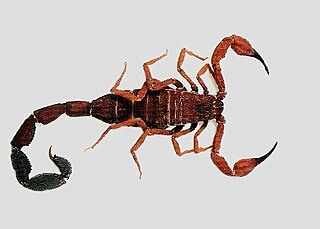
Tityus is a large genus of thick-tailed scorpions, the namesake of its subfamily Tityinae. As of 2021, Tityus contains more than 220 described species distributed in Central America and South America, from Costa Rica to Argentina. Species in the genus Tityus have been studied for hundreds of years, long before the taxonomic classification was put in place. Tityus tend to be of medium size for scorpions, roughly 50 to 70 millimeters long. They are dark brown or red in color, and can exhibit sexual dimorphism. They can live in a variety of environments, ranging from urban to arid mountains to the Amazon Rainforest. Tityus scorpions are best known for their venom and potent sting. The genus contains several dangerously venomous scorpions, the best known of which is the Brazilian yellow scorpion, T. serrulatus. Its venom can cause severe illness, and in the young, old and infirm even death. Some experts have argued that the genus as a whole may be paraphyletic, which could explain the knowledge gaps related to Tityus.
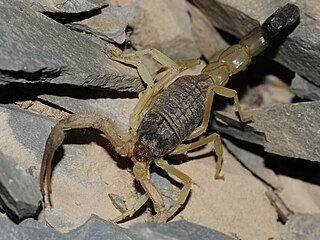
Hottentotta is a genus of scorpions of the family Buthidae. It is distributed widely across Africa, except for most of the Sahara desert. Species in the genus also occur in the Middle East, the Arabian Peninsula, southeastern Turkey, Iraq, Iran, Afghanistan, Pakistan, India, Nepal, Cape Verde Islands, and Sri Lanka (introduced).

Ananteris sabineae is a species of scorpion. It is closely related to Ananteris pydanieli, and is often described in relation to it. It has a pale pigmentation of its pedipalps and legs, and a carapace with darker pigmentation and less conspicuous yellow spots.
Ananteris pydanieli is a species of scorpion from the Brazilian Amazon rainforest. It is a member of the family Buthidae.

Leiurus is a genus of scorpion of the family Buthidae. The most common species, L. quinquestriatus, is also known under the common name Deathstalker. It is distributed widely across North Africa and the Middle East, including the western and southern Arabian Peninsula and southeastern Turkey. At least one species occurs in West Africa.
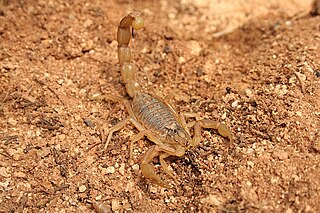
Buthus is a genus of scorpion belonging and being eponymous to the family Buthidae. It is distributed widely across northern Africa, including Morocco, Mauritania, Algeria, Tunisia, Libya, Egypt, Senegal, Guinea-Bissau, Nigeria, Sudan, Somalia, Ethiopia, Djibouti, as well as the Middle East, including Israel, Palestine, Jordan, Lebanon, Iraq, Yemen, and possibly Saudi Arabia and southern Turkey. Its European range includes the Iberian Peninsula, southern France, and Cyprus.
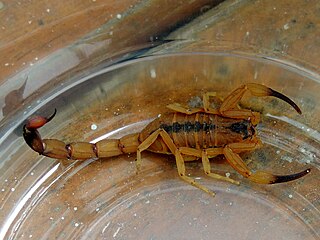
Tityus stigmurus is a species of scorpion from the family Buthidae that can be found in Brazil. The species are 4.5–6 centimetres (1.8–2.4 in) in length and are either golden-tan or yellowish-brown coloured. It takes them a year to mature into an adult, which makes them a fast-growing species. They also have a dark stripe over the mesosoma with either yellowish or orange pedipalps.
Reddyanus basilicus is a species of scorpion in the family Buthidae.
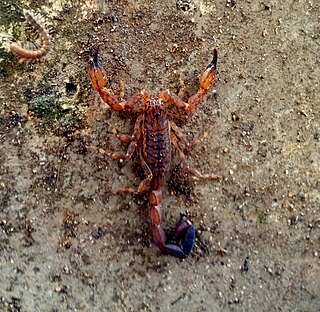
Reddyanus besucheti is a species of scorpion in the family Buthidae endemic to Sri Lanka.
Reddyanus bilyi is a species of scorpion in the family Buthidae. It is endemic to Australia.
Isometrus thurstoni is a species of scorpion in the family Buthidae. The newly discovered Isometrus species, Isometrus kovariki, from the Western Ghats region of India, is closely related.
Isometrus thwaitesi is a species of scorpion in the family Buthidae endemic to Sri Lanka.
Reddyanus loebli is a species of scorpion in the family Buthidae.
Centruroides robertoi is a species of scorpion in the family Buthidae.
Centruroides baergi is a species of scorpion in the family Buthidae. They are commonly found in highlands and are almost exclusively found in the states of Oaxaca and southern Puebla, Mexico. C. baergi is the most abundant scorpion of the genus in the state of Oaxaca, making up a third of Centruroides reported between 2008 and 2014.
Ananteris nairae is a scorpion species found in Brazilian Amazonia. The species has the most western distribution of the species in Ananteris. The specific epithet refers to Nair Otaviano Aguiar.
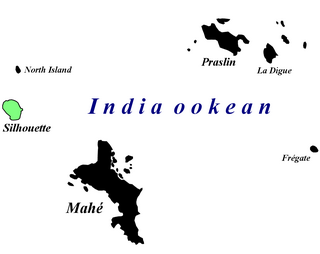
Afrolychas braueri, commonly known as the Seychelles forest scorpion, is a species of scorpion in the family Buthidae. It is currently thought to survive only on Silhouette Island, Seychelles, although the species was historically found on two additional Seychellois islands. This scorpion lives in leaf litter in forests that are largely unaffected by invasive plant species. It is a small yellowish-brown scorpion with three prominent keels on the dorsal surface of its mesosoma, which distinguishes it from other scorpions. While not much is known about the Seychelles forest scorpion's ecology due to the paucity of sightings, it is known to rely solely on its venom to capture its prey and defend its young. Its venom is not dangerous to humans.

Ananteris bernabei is a species of scorpion in the family Buthidae. It was first described in a 2009 paper along with the species Ananteris chagasi and Ananteris kuryi. It is endemic to Espírito Santo, Brazil.

Ananteris kuryi is a species of scorpion in the family Buthidae. It was first described in a 2009 paper along with the species Ananteris chagasi and Ananteris bernabei. It is endemic to Bahia, Brazil.











